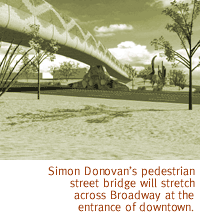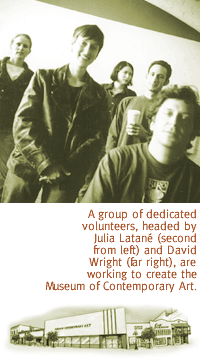

|

It Was A Year Of Transition, But Also Elation On The Local Arts Beat.
By Margaret Regan
THE CHORUS OF Handel Hallelujahs and Amens delivered by
the Catalina Chamber Orchestra and singers in last week's Messiah
brought the arts year to a triumphant end. People glanced around
tentatively before taking to their feet for the Hallelujah chorus,
but when they found the courage to leap up it was with a sense
of awe that a work of art 256 years old could still move them
to tears.
It would be more than cruel to judge Tucson artists by the Handel
genius standard, but there's plenty to be proud of this year in
the many varieties of Old Pueblo arts. Still, 1998 has been a
transitional year. The Tucson Arts District has gone through
convulsions, with 4-year-old Bero Gallery failing and that
longtime stalwart, Café Magritte, shutting its doors
on Congress Street. Huge crowds drive downtown for operas, concerts
and plays at the Tucson Convention Center and the Temple of Music
and Art, and right afterward zip back out, leaving a plume of
auto exhaust hovering over the empty storefronts. The Downtown
Business Alliance, the new Business Improvement District, may
or may not be part of the answer to downtown's woes, but it started
up unpromisingly under a twin burden of ethical missteps and contempt
for public process.
 But underneath the decay, there are signs of new life. DC/Harris
Gallery started up in Bero's old space, and Eric Firestone
opened another at the east end of Congress. A couple of daring
public art projects--Simon Donovan's pedestrian snake bridge
and Steve Farley's photographic installations--got the
go-ahead, and by next summer will add some distinctive and eccentric
art to the Broadway underpass at downtown's east end. A team of
determined thirtysomething artists is conspiring to persuade downtown's
worst landlord, the federal government, to give them the dead
block of buildings on Congress between Stone and Scott avenues
for a new Museum of Contemporary Art. In the meantime,
they've opened up a Temporary Contemporary in an old warehouse
on Toole Avenue. Dubbing it Haz Mat Gallery, they opened
this month with a first show of wild contemporary works.
But underneath the decay, there are signs of new life. DC/Harris
Gallery started up in Bero's old space, and Eric Firestone
opened another at the east end of Congress. A couple of daring
public art projects--Simon Donovan's pedestrian snake bridge
and Steve Farley's photographic installations--got the
go-ahead, and by next summer will add some distinctive and eccentric
art to the Broadway underpass at downtown's east end. A team of
determined thirtysomething artists is conspiring to persuade downtown's
worst landlord, the federal government, to give them the dead
block of buildings on Congress between Stone and Scott avenues
for a new Museum of Contemporary Art. In the meantime,
they've opened up a Temporary Contemporary in an old warehouse
on Toole Avenue. Dubbing it Haz Mat Gallery, they opened
this month with a first show of wild contemporary works.
The Warehouse District just north of downtown's railroad
tracks is positively thriving. And cool, definitely. Davis
Dominguez Gallery, transplanted from the foothills, is in
situ in its new digs in an old plumbing storehouse on Sixth
Street. At the far south end of the same building, on Seventh
Street (these warehouses are nothing if not big), Orts Theatre
of Dance is happily occupying its renovated Movement Warehouse
studios. Photographer José Galvez revamped his gallery
as the Mexican American Cultural Art Center, abandoned
Fourth Avenue and followed Davis Dominguez to Sixth. Also newly
installed on the street are artist Susan Gamble and her
Santa Theresa Tileworks, and landscape architects Wheat
Scharf. At Fifth Avenue, the International Arts Center
has come a long way in its renovation of the old YMCA building;
a dozen artists are already in residence.
As for the art itself, there's lots of good to report. Painter
Bailey Doogan's one-woman show of gigantic charcoal drawings
at the University of Arizona Museum of Art this fall may be all
by itself in this year's jaw-dropper category. Her stark, aggressive
drawings--of naked, aging women, of an ethereal child dead of
abuse, of an Irish rebel killed in action--covered a roomful of
walls. They were stunning, and beautiful. A close second was Robert
Colescott, the Tucson artist who brought his paintings from
the Venice Biennale home to the UAMA. Diving across continents
and centuries, Colescott's big bright paintings about race, culture
and gender were difficult and gorgeous all at once. Come to think
of it, the UAMA, which also did the ear-splitting Dennis
Oppenheim installation about the U.S. Mexican border, this year
gets the prize for least-staid museum.
 Rival Tucson Museum of Art's exhibitions were hampered by the
$2.7 million construction project that shut the museum's doors
all winter. After adding some 5,000 feet of new gallery space,
the TMA re-opened with a huge survey of Spanish arts and crafts
in the New World. Full of handmade sailing ships and carved Virgins,
El Alma del Pueblo was a wholly laudable enterprise
somewhat marred by the blatant commercialism of its sponsor, a
car maker who shall here remain nameless. And in a downtown that
is too empty at night, the restaurant space formerly known as
Janos is now forlornly contributing to the evening darkness. The
museum is converting the space to a gallery. But it's good to
see the return of the museum's adventurous New Directions
series featuring Tucson artists, with photographer Amy Zuckerman
first up, then Daniel Martin Diaz.
Rival Tucson Museum of Art's exhibitions were hampered by the
$2.7 million construction project that shut the museum's doors
all winter. After adding some 5,000 feet of new gallery space,
the TMA re-opened with a huge survey of Spanish arts and crafts
in the New World. Full of handmade sailing ships and carved Virgins,
El Alma del Pueblo was a wholly laudable enterprise
somewhat marred by the blatant commercialism of its sponsor, a
car maker who shall here remain nameless. And in a downtown that
is too empty at night, the restaurant space formerly known as
Janos is now forlornly contributing to the evening darkness. The
museum is converting the space to a gallery. But it's good to
see the return of the museum's adventurous New Directions
series featuring Tucson artists, with photographer Amy Zuckerman
first up, then Daniel Martin Diaz.
More visual art highlights: Cynthia Miller's velvety blue
"Monsoon Chair," a work on paper at Pima Community College;
Kate Breakey's dead painted birds, magnified to startling
effect in photographs at Etherton Gallery; Ansel Adams'
serene miniatures of nature at the Center for Creative Photography,
juxtaposed against pictures of the worst humanity has to offer.
Adams' lovely bits of snowflakes and tree barks and blossoms were
paired with stark-eyed portraits of Cambodians photographed just
before they went off to slaughter in the killing fields. One cannot
easily forget the look in the eyes of a mother soon to die, her
infant in her arms.
The incomparable Mark Morris at Centennial Hall was the
hands-down highlight in a busy dance calendar. A fan of Baroque
music, Morris' most exhilarating work, "I Don't Want to
Love," paired pared-down movement by dancers in white
with gorgeous Italian madrigals, sung live by a quartet of impossibly
rich voices. Ballet Arizona, which grows better by the
month, undertook a wonderful re-staging of the Kurt Jooss classic
"The Green Table," a dance-theatre piece spawned
in 1930s Germany. Here dance was everything it can be: historical,
metaphorical, lyrical. Orts Theatre of Dance admirably
continued to give itself new tasks. This year's Thanksgiving concert
was a delirious blend of modern dance, Portuguese chants and the
movements of capoeira, a Brazilian martial arts form that
has shadowy roots in the world the slaves made. Local independent
choreographer Ellen Bromberg moved into a new video dimension
with "Falling to Earth," an emotional, multi-media
work about death. The upstart NEW ARTiculations dance troupe,
a young group eager to showcase its own choreography, proves reassuringly
that the more things change, the more they stay the same.
Arizona Opera moved into the next generation with its
new director, David Speers, and his first two productions
hinted at greater theatrical fluidity. Strauss's Die Fledermaus,
in November, was a pure joy. The Arizona Friends of Chamber
Music continue to bring plaudits to Tucson with their Winter
Chamber Music Festival. I defer to my more knowledgeable musical
colleagues in reporting the Tucson Symphony Orchestra continues
to advance under its newish director, George Hanson. The
local poetry scene thrives under the careful tending of CHAX
Press and Kore Press, the UA Poetry Center,
POG and the UA Extended University. A POG event
at South Tucson's Las Artes, a tile-art program for teens, attracted
a big audience far from the usual poetry precincts.
The low point of my final months as theatre reviewer occurred
when I arrived for a play to find the actors standing forlornly
outside the theatre in their costumes. Not a single audience member
had showed up except for me. We agreed together that the show
must go on, and during the ensuing performance my good nature
compelled me to laugh loudly at every joke. It was the loneliest
night yet on an unusually lonely beat, the local theatre scene.
I have since ceded it to the more patient Dave Irwin, yet I saw
some fine work before I did.
Tucson Art Theatre, which surfaces only occasionally,
turned out an exquisite and demanding Cerceau, a
modern Russian update on Chekhovian themes. Invisible Theatre
turned serious with Kindertransport, an imaginatively
staged work about the lasting damage done to child survivors of
the Holocaust. The traveling Rent at Centennial
Hall was unabashedly good; and so was Tim Miller's one-man
performance piece about love and life and the everlasting search
for a good New York apartment.
Finally, Eugene O'Neill's Long Day's Journey into Night
was the finest play that Arizona Theatre Company has undertaken
in years. There was nothing about the production that wasn't perfect:
not script, not cast, not set, not direction. It was a wholly
absorbing, wholly pleasurable, serious and funny and wonderful.
As a matter of fact, it just might have met the Handel standard.
Here's to more of the same.

|
 |





